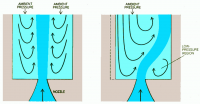








The Coanda effect is the tendency of a fluid jet to be attracted to a nearby surface.The principle was named after Romanian aerodynamics pioneer Henri Coanda, who was the first to recognize the practical application of the phenomenon in aircraft development.
An early description of this phenomenon was provided by Thomas Young in a lecture given to The Royal Society in 1800
The lateral pressure which urges the flame of a candle towards the stream of air from a blowpipe is probably exactly similar to that pressure which eases the inflection of a current of air near an obstacle. Mark the dimple which a slender stream of air makes on the surface of water. Bring a convex body into contact with the side of the stream and the place of the dimple will immediately show the current is deflected towards the body; and if the body be at liberty to move in every direction it will be urged towards the current..
A hundred years later, Henri Coanda identified an application of the effect during experiments with his Coanda-1910 aircraft which mounted an unusual engine designed by Coanda. The motor-driven turbine pushed hot air rearward, and Coand? noticed that the airflow was attracted to nearby surfaces. He discussed this matter with leading aerodynamicist Theodore von Karman who named it the Coanda effect.In 1934 Coanda obtained a patent in France for a "Method and apparatus for deviation of a fluid into another fluid". The effect was described as the "Deviation of a plain jet of a fluid that penetrates another fluid in the vicinity of a convex wall."